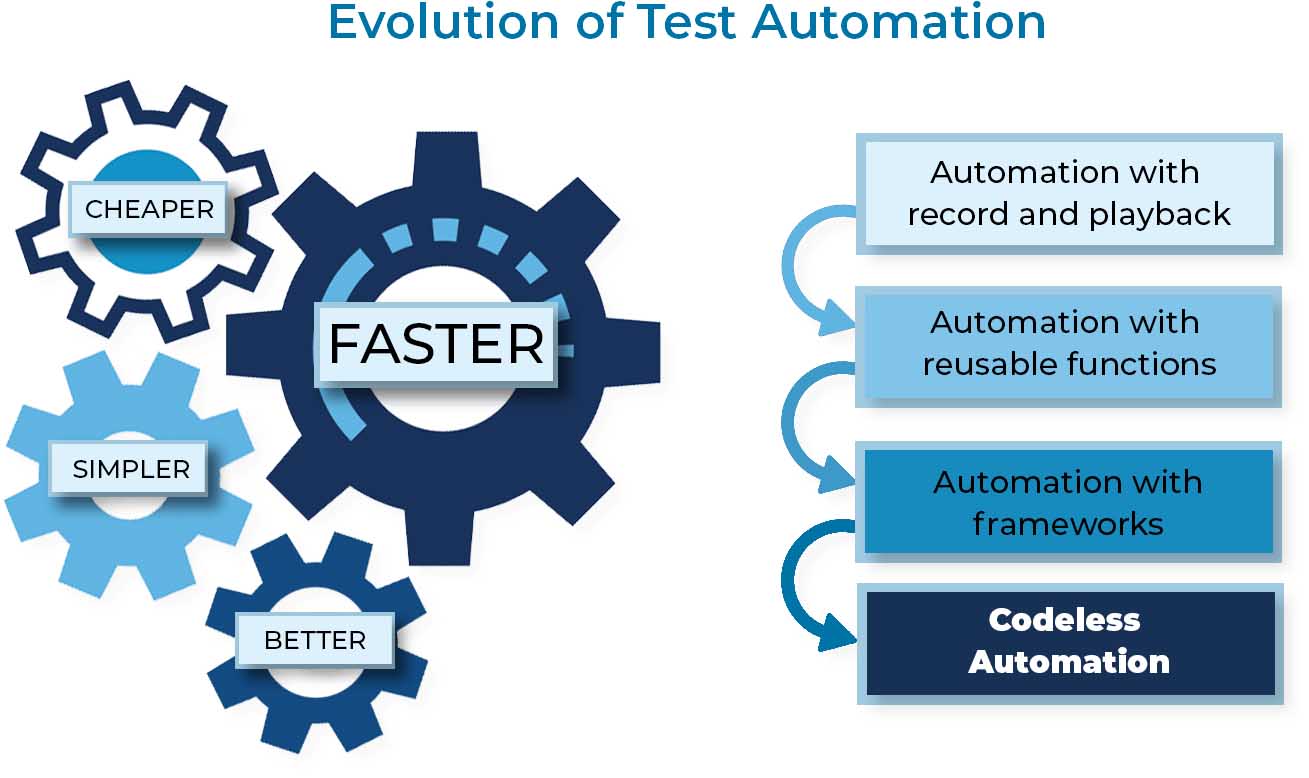
By nature, the world of technology and software development is constantly changing. What it is, what it can do, and how it is created are all dynamic, evolving to meet the demands asked of it. However, despite these shifting expectations, there is a constant ask that is unlikely to diminish, instead, only grow in intensity: that it be done FAST!
Shortening release cycles, introducing updated features quickly, and responding to the changing trends in the market rapidly are the new demands, and many teams have already heard the call! Take Development, for example; they answered the call for speed with their Agile and DevOps methodologies – and I think we all know that has been working quite well. But where did that leave QA and Testing Teams?
Manual Testing & Test Automation
Given this new paradigm, it was clear that manual testing couldn’t keep pace with Agile and DevOps to the extent demanded of it. In response, test automation was introduced, reducing or eliminating the mundane, repetitive, time-consuming, and often error-prone task of manual testing. Unfortunately, automating large test suites is not easy or practical, especially when you take into account the majority of test automation tools are code-reliant, and likely, less than a majority of your QA team can write code.
Fortunately, much like test automation was a response to the drudgery of manual testing, there is an answer to the prevalent inability of QA teams and testers to execute automation without having to learn code. It is called Codeless Automation Testing, and today, we are going to learn if it really can deliver on the value that QA teams hope it can. After all, isn’t the point of Test Automation to free up resources, not bog them down?
What is Codeless Automation?

evolution of test automation.
automation with record and playback, automation with reusable functions, automation with frameworks, codeless automation.
Much like the name suggestions, Codeless Automation refers to automating test cases without the need to write code. Typically, the codeless test automation approach is a familiar one, based off of Record and Playback. In this instance, a tool would automatically record all the test steps into a script while a tester performs them manually. Once the recording is finished, the script can be replayed and used again and again.
However, unlike the legacy approach or tools you might be familiar with that record static test cases, today’s offerings come equipped with artificial intelligence and machine learning capabilities that allow you to create and edit the test steps manually, creating structured test flow diagrams.
Although the name paints a different picture, it’s important to establish that codeless automation is not 100% codeless. In reality, what happens is that while the tester is recording the test, the codeless automation testing tools are working in the background, creating a layer of abstraction that translates the user’s interaction to code. This allows for QA and Testers to focus on QA and testing rather than learning how to write code.
Advantages of Codeless Automation

Change for the sake of change is rarely beneficial. However, the appeal of Codeless Automation, as I already briefly touched upon earlier, is that it was a response to a genuine need and shortcoming in the QA world, especially those expected to support the life cycle of Agile development. Other benefits that have some flocking to codeless automation include:
- User-Friendly UI: Unlike code-based automation tools, codeless test automation tools have rich UI that comes with the promise of a quick, easy and codeless experience
- Keeps Pace with Development: Designed with graphical UI workflows, code is created to make automation easy to learn and implement, matching the pace of agile through continuous integration and testing.
- Lowers Maintenance Cost & Scalability: Flows can be combined and reused as sub-flows across additional testing use cases. When something is changed in these sub-flows, the changes reflect across all test cases holding that module, making automation flow corrections basically obsolete.
- Increase Automation Adoption: Codeless automation tools can be used as a holistic automation solution across an organization, unlike code-based frameworks that require a specific skill set to utilize fully. This removes a significant barrier to automation.
- Greater Process & Change Documentation: Detailed visual descriptions of processes, video recordings, and logs are all effortlessly created and stored to ensure an accurate and easily auditable account of what happened.
Disadvantages of Codeless Automation
Just as every coin has two sides, so too does almost every business case have two opinions. And while the above benefits surrounding codeless automation are appealing and hard to refute, there are also some limitations and disadvantages associated with it. In fact, once you start using a codeless automation tool, you’ll likely notice a few things and get a greater sense of the picture:
- Lack of Customization: Automation is processed in the background, leaving little to no opportunity for testers to modify the scripts.
- Not REALLY Codeless: Although scripts are created and structured automatically, instances can (and likely, will) arise that will require some manual coding.
- Maintainability is Challenging: If tests weren’t designed to be reusable or modular, issues could arise in maintainability as the number of tests is continuously growing, and the application is continually changing.
- Interoperability Issues: No codeless test automation solution is universal, with either platform dependency or interoperability issues between multiple browsers and software support, leading to unexpected outcomes.
- Bugs & Glitches: Although computer-generated, it is not infallible and improper coverage can lead to bugs and glitches in the script. If that script is reusable and modular, that could lead to the recorded script playing back incorrectly or invalid test results.
How to Get the Most Out of Codeless Automation

It is easy to get excited at the prospect of experiencing 100% codeless automation, but it is more important to keep your expectations rooted in reality. The truth is, we are only experiencing the nascent stages and are still a little while off from the authentic, seamless experience that will take codeless test automation from where it is today to widespread adoption. That is because, at present, 100% codeless automation is near impossible to achieve, given the growing complexity of current software systems.
However, that isn’t to say codeless automation isn’t without its place and time, and the benefits above are still real, just perhaps not to the degree you’d hope for. Our experience has taught us that at present, codeless automation is best suited for fundamental to intermediate test cases, leading to
- Faster development and script deployment cycles
- Removal of skill barriers and enhancing automation adoption
What Codeless Automation Needs
While admittedly, codeless automation isn’t codeless or able to handle the full breadth of modern complex software systems, it is still at a great jumping-off point towards achieving it. But, before codeless automation will ever really take off, I believe that it needs to add some key capabilities, many of which, are already under development and available:
- Smart Element Locators: By gathering more than one element during the recording, alternative elements can be used if the original is not found in playback.
- Conditional Waiting: Instead of waiting “x” number of seconds before continuing to the next step, they wait until the condition is true and then proceed as soon as possible.
- Reusable Steps: Test authors should be able to record common steps and insert them into any test flow later, promoting reusability and saving time.
- Cross-Browser Support: Many tools come as browser extensions, meaning they could be tied to a specific browser. Ideally, test authors should be able to record on one browser and play it back on another
- Ability to Insert Code: No tool is perfect, and letting the author have the ability to insert code for specific cases is helpful.
Take Away
Codeless automation is cause for excitement, but we are still some time away from reaching its full potential, let alone seeing its mass adoption. That is because the limitations are too great to make a significant impact on the complex reality that is modern software development. But that will change in time as most things in technology inevitably do.
As the prevalence of methodologies like agile and DevOps grow, so will the need for QA solutions that can keep pace with this accelerated level. Codeless automation stands to be that solution, enabling a broader range of users to utilize test automation. And while the benefits are certainly appealing, and the barrier of entry diminishing, I would say that the real excitement and value of codeless automation have yet to make themselves known.



